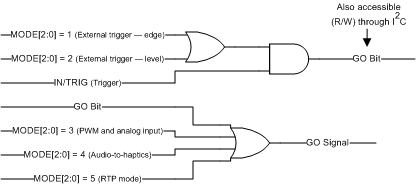ZHCSEJ7B October 2015 – April 2018 DRV2605L-Q1
PRODUCTION DATA.
- 1 特性
- 2 应用
- 3 说明
- 4 修订历史记录
- 5 Pin Configuration and Functions
- 6 Specifications
-
7 Detailed Description
- 7.1 Overview
- 7.2 Functional Block Diagram
- 7.3
Feature Description
- 7.3.1 Support for ERM and LRA Actuators
- 7.3.2 Smart-Loop Architecture
- 7.3.3 Open-Loop Operation for LRA
- 7.3.4 Open-Loop Operation for ERM
- 7.3.5 Flexible Front-End Interface
- 7.3.6 Edge Rate Control
- 7.3.7 Constant Vibration Strength
- 7.3.8 Battery Voltage Reporting
- 7.3.9 Low-Power Standby
- 7.3.10 I2C Watchdog Timer
- 7.3.11 Device Protection
- 7.4 Device Functional Modes
- 7.5
Programming
- 7.5.1 Auto-Resonance Engine Programming for the LRA
- 7.5.2 Automatic-Level Calibration Programming
- 7.5.3 I2C Interface
- 7.5.4 Programming for Open-Loop Operation
- 7.5.5 Programming for Closed-Loop Operation
- 7.5.6 Auto Calibration Procedure
- 7.5.7 Waveform Playback Programming
- 7.6
Register Map
- 7.6.1 Status (Address: 0x00)
- 7.6.2 Mode (Address: 0x01)
- 7.6.3 Real-Time Playback Input (Address: 0x02)
- 7.6.4 (Address: 0x03)
- 7.6.5 Waveform Sequencer (Address: 0x04 to 0x0B)
- 7.6.6 GO (Address: 0x0C)
- 7.6.7 Overdrive Time Offset (Address: 0x0D)
- 7.6.8 Sustain Time Offset, Positive (Address: 0x0E)
- 7.6.9 Sustain Time Offset, Negative (Address: 0x0F)
- 7.6.10 Brake Time Offset (Address: 0x10)
- 7.6.11 Audio-to-Vibe Control (Address: 0x11)
- 7.6.12 Audio-to-Vibe Minimum Input Level (Address: 0x12)
- 7.6.13 Audio-to-Vibe Maximum Input Level (Address: 0x13)
- 7.6.14 Audio-to-Vibe Minimum Output Drive (Address: 0x14)
- 7.6.15 Audio-to-Vibe Maximum Output Drive (Address: 0x15)
- 7.6.16 Rated Voltage (Address: 0x16)
- 7.6.17 Overdrive Clamp Voltage (Address: 0x17)
- 7.6.18 Auto-Calibration Compensation Result (Address: 0x18)
- 7.6.19 Auto-Calibration Back-EMF Result (Address: 0x19)
- 7.6.20 Feedback Control (Address: 0x1A)
- 7.6.21 Control1 (Address: 0x1B)
- 7.6.22 Control2 (Address: 0x1C)
- 7.6.23 Control3 (Address: 0x1D)
- 7.6.24 Control4 (Address: 0x1E)
- 7.6.25 Control5 (Address: 0x1F)
- 7.6.26 LRA Open Loop Period (Address: 0x20)
- 7.6.27 V(BAT) Voltage Monitor (Address: 0x21)
- 7.6.28 LRA Resonance Period (Address: 0x22)
- 8 Application and Implementation
- 9 Power Supply Recommendations
- 10Layout
- 11器件和文档支持
- 12机械、封装和可订购信息
7.4.3 Operation of the GO Bit
The GO bit is the primary way to assert the GO signal, which fires processes in the DRV2605L-Q1 device. The primary purpose of the GO bit is to fire the playback of the waveform identifiers in the waveform sequencer (registers 0x04 to 0x0B). However, The GO bit can also fire the calibration or diagnostics processes.
When using the GO bit to play waveforms in internal trigger mode, the GO bit is asserted by writing 0x01 to register 0x0C. In this case, the GO bit can be thought of as a software trigger for haptic waveforms. The GO bit remains high until the playback of the haptic waveform sequence is complete. Clearing the GO bit during waveform playback cancels the waveform sequence. The GO bit can also be asserted by the external trigger when in external trigger mode. The GO bit in register 0x0C mirrors the state of the external trigger.
Setting RTP mode , PWM mode, or audio-to-vibe mode also sets the GO bit. However, setting the GO bit in this way has no impact on the GO bit located in register 0x0C.
 Figure 18. GO-Signal Logic
Figure 18. GO-Signal Logic